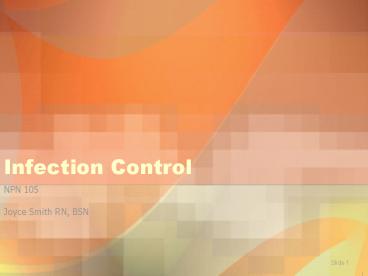Infection Control - PowerPoint PPT Presentation
1 / 18
Title:
Infection Control
Description:
Infection control and prevention are important functions. Knowledge of infectious process, critical thinking, ... Usually physician will prescribe and antibiotic ... – PowerPoint PPT presentation
Number of Views:5660
Avg rating:3.0/5.0
Title: Infection Control
1
Infection Control
- NPN 105
- Joyce Smith RN, BSN
2
(No Transcript)
3
Changes in Control of Infections
- Onset of HIV
- Insurgence of TB form endemic countries
- Increase in hepatitis
- Increase in immigrants
- Hospital cost containment
- Nosocomial infections
4
Infection Control
- Infection control and prevention are important
functions. - Knowledge of infectious process, critical
thinking, aseptic techniques, and barrier
protections cannot be overemphasized. - Nurses are the primary preventers of infectious
diseases in health care
5
Scientific Knowledge Base
- Nature of infection
- Invasion of susceptible host by pathogens or
microorganisms which results in disease - Infecting agents
- Bacteria, virus, fungi, protozoa
- Colonization
- Occurs when a microorganism invades and grows but
does not cause disease or infection - Disease occurs only after the pathogens multiply
and cause problems with tissue function
6
Chain of Infection
- Infectious agent
- and ability to produce disease
- Reservoir
- Places where the microorganism lives and
survives H2O, humans, animals, organic matter - Portal of exit must leave host
- Mode of transmission how it gets from one to
another - Portal of entry must have entrance
- Susceptible host amount of defenses
7
Modes of Transmission
- Contact
- Air
- Vehicles
- Vector
8
Defenses Against Infection
- Normal flora
- Body system defenses
- Inflammation
- Immune response
9
Health CareAssociated Infection
- Patients with multiple illnesses, older adults,
and the poorly nourished are more susceptible. - Those with HIV, diabetes mellitus, and
malignancies have a lowered resistance to
microorganisms. - Can be exogenous or endogenous
- Exogenous not part of normal body flora
- Endogenous part of normal body flora
10
Asepsis
- Medical asepsis
- Use of clean techniques
- Hand hygiene, barrier technique, cleaning of
environment and surfaces - Surgical asepsis
- Highest level of protection
- Use of sterile techniques
- Surgical hand washing, gown, gloves, mask
- Nurses use this technique when doing sterile
dressings or treatments
11
Knowledge Base
- Infectious diseases create feelings of anxiety,
frustration, and anger. - Cultural, religious, or social beliefs influence
reactions. - Beliefs about disease and vaccination influence
vaccination decisions.
12
Infection Control
- Health promotion
- Nutrition
- Hygiene
- Immunization
- Adequate rest and regular exercise
13
What to do When an Infection Occurs in Your
Patient
- Disinfect and sterilize all supplies
- Good hand washing prevents the spread
- Use of barriers, such as masks, gowns and gloves
to control exposure - Isolate if necessary to prevent spread
14
Treatment of an Infection
- Must identify the organism
- Usually physician will prescribe and antibiotic
- Increase fluid intake if patient condition allows
- Allow for rest periods
- Change dressings as needed and dispose of
dressing in containers - May use compresses to site or may need to manage
drainage tubes
15
Controlling Infections
- Medical sepsis
- Control or elimination of infectious agents
- Cleaning
- Disinfection and sterilization
- Control or elimination of reservoirs
- Control of portals of entry
- Control of transmission
- Hand hygiene
16
HAND WASHING
- Before contact with patients
- Before putting on sterile glove
- After removal of sterile gloves
- After contact with patients skin
- After contact with body fluids
- After contact with contaminated equiptment
17
Infection Control
- Isolation and barrier protection
- Standard precautions
- Personal protective equipment (PPE)
- Specimen collection
- Bagging
- Removal of protective equipment
- Transporting patients
18
Infection Control
- Role of infection prevention and control
- Most health care facilities have infection
control departments - Collect and report infections and identify needs
- Health promotion in health care workers and
patients - Immunizations for employees
- Teaching reinforcement in infection control
policies - Manage job related infections
- Stay home if contagious































